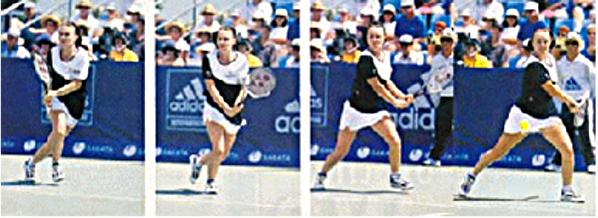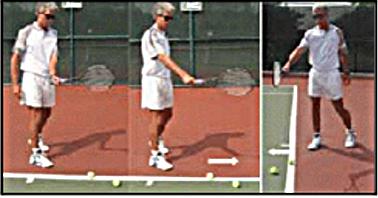|
|
|
| MODERN TENNIS | |
|
IMPROVE YOUR BACKHAND No, you move first. As with the forehand, “take the racket back” is a process. Only during a lesson when developing muscle memory will you literally “take the racket back” first and then move. Martina Hingis shows this process in the picture below. She’s moving, taking steps, then taking the racket back fully just before the forward stroke. You can “turn” or curl the front shoulder a little more than what’s comfortable when you’re two steps away from hitting the ball. When “turning” the shoulder at this time it won’t throw the body into the wrong direction, whereas if you “turn” from the get-go you’re off to the side fence.
When the racket’s back, notice I said “when,” you should carry the racket hand waist high. This ensures your arm bends, or folds, like it’s supposed to. If the ball’s low or high, you still do this, one or two handers. Okay. You’ve moving all right, and you’re getting the racket back, and you’re seeing the ball well. Now what do you do, you ask. One handers have to stop farther away from the ball than on a forehand. Two handers don’t have this problem. You need to plan for it, and not lose your balance over it (well, you actually will, so plan for it).
There are plenty of photos that show a backhand’s contact is “farther out in front of you” than on a forehand (photo below martina's). But the contact on a one handed backhand is also farther away from the body laterally than on a forehand, shown by the tennis balls in the other two photos to the right. By the way, my arm is not lock-arm straight here. When two handers swing, with the extra torque two hands and arms provide you’ll literally pull yourself away from the ball, and, guess what happens.... You lose your balance. Again. Solution? Keep your upper body and head back, and don’t let the swing uproot you. DON’T LEAN INTO THE BALL, DON’T BEND OVER Keep your weight on that back foot. Keep your body weight back. Sure, when you’re moving forward to the ball your torso will be leaning over, but that’s when it’s time to say, “whoa, nellie!” Pull back. Pull that torso back, keep it upright, like Guga (and Hewitt) does so splendidly. (see picture below) It’s possible that even though both feet point at and into the ball on the stroke, the knees and hips can point inward, away from the ball, compromising the body’s support. This happens to me. With my front foot pointed into the ball, my front knee turns inward, toward the back foot, as does my front hip. I have to consciously open these to match the alignment with the front foot. Shift the body weight into the ball, which means on an angle with regard to the court surface below you and NOT to the net, NOT in the direction of the ball’s placement. Ah, and now the swing. I can feel you’re choking already. A strong backhand, like your forehand, is all about a process. movement direction stroke preparation vision balance the Forward Stance self discipline @ stroke time
equals = a strong backhand. Notice there’s nothing there about keeping the ball in, it’s all about a strong backhand. And that’s what you’ve got to come to grips with, that you have a strong backhand. Once you realize that, two things will happen. You won’t choke, and the ball will come in. HIT THE BALL ON TIME - USE WRISTSEvery stroke is about putting the strings on the ball on time, which often means the racket head is out ahead of the hand. The backhand is no different, the hand(s) swings the racket head. When you swing the racket, in order for the racket head to get from the backswing position to “out in front,” the front shoulder won’t really move, the biceps doesn’t swing out toward the net, the elbow doesn’t stick out toward the net, and the hand doesn’t extend out to the net. Why? So the racket head can get into position. On one handers the arm unfolds during the swing, or, to use another term, the arm sweeps across the court (a grand gesture) out to the ball all the while making sure the elbow and biceps don’t head out to the ball first. If, however, the racket face doesn’t contact the ball on time and send it crosscourt sweetly, I discretely ask you break the wrist ever so gently to get the racket face moving first when it first starts its forward swing. This isn’t a wristy kind of a thing, nor does the wrist move as much as it does on a forehand. It merely is a suggestion to experiment with. There is no sweeping motion for two handers since the arms remain in close to the body. But I am noticing two hander students tend to keep both wrists literally locked during backswing and forward swing. And this inhibits performance. After I recommend that a student “relax the wrists” during the backswing and forward swing the student often hits better. Relaxing the wrists helps take the racket back, and “relaxing” doesn’t mean the wrist is loose like cooked spaghetti. No, you’re in control of the wrists. Since a two hander is often interpreted as a forehand using the non dominant hand, since on a regular forehand the wrist is used, why not when a two handed backhand? UNLEASH IT - BANG ITYou swing fluidly, or maybe not so fluidly, on your forehand. Regardless, you feel confident on the forehand and you bang it. Why not on the backhand? Bang it, man. Set yourself up and then bang it. But it’s a different banging, a different animal than the forehand. The forehand is more like a shotgun, the backhand a bow and arrow. Ball goes out? Reign in the stroke, but not the fluidness, not the full, free stroke. Reign it in by not swinging across, not swinging up to the sky, by not opening the racket face at contact. Do what it takes to prevent the racket face from opening at contact - supinate the hand, change the grip, angle your wrist. CHOICES, CHOICESNow with your new backhand you’ll have to decide: to slice, to top, what shall I do? Two handers can do the same thing all the time, but one handers need to choose. If the ball is chest high and above, a slice is generally the preferable choice. When lower than that, you can both slice and top. But decide before the ball’s bounced on your side or you’ll confuse yourself, which doesn’t make for a pretty shot. The secret to hitting strong backhands has already been covered in earlier Steps. Footwork, movement, balance, vision, all lay the foundation, just like on the forehand. Adjusting for the ball’s different approach direction to you is covered in Grand Unification Theory. If you’ve understood how this all works for the forehand, merely flip it over, like a mirror image, and apply it to your backhand. Of course the stroke’s a little different, in some respects, but the objectives of hitting on time and through the middle of the ball remain the same as on the forehand. The hardest thing on the backhand is keeping the arm quiet in the beginning of the forward swing to start the slow process of getting the racket around without moving the front shoulder or rotating the torso. Backhands are harder to adjust at the last minute than forehands for precisely this reason. The stroke is more committed at an earlier part in its forward swing because the arm extends out to, rather than compressing into, the ball. My own personal checklist on a backhand works like this. Front shoulder turned or curled, head open and steady, torso upright, back knee turn in, front knee opened, weight on back leg, stay away sufficiently, sweeping motion, figure out the wrist and hand angle, use eyes to glance at ball. That’s about it. If you felt there should be more here, remember that at the end of The Wizard of Oz the Wizard himself is revealed to be mortal. Same with the backhand. Don’t be intimidated. The solutions, delivered in earlier Steps, are already known to your forehand (footwork, movement, forward stance, balance, vision), and are ready to be implemented by you. Next up will be either volley or return, or both.
|
||
|
|
||

|
||
|
|
||

|
||
|
|
||

|
||